SHADOWLAND® ‘Hudson Bay’
Hosta
AGES LIKE A FINE WINE
- Striking tricolor blue, apple green and creamy white variegation
- Thick leaves are more slug and snail resistant
- Near-white flowers attract hummingbirds
- Very easy to grow, long-lived and shade tolerant
- Best in filtered shade or morning sun, but will also grow well in full shade
- Measures 2′ tall x 2′ spread
- Cold hardy perennial for USDA zones 3-9
- Pronounced “HAH-stuh”
Good things take time, and this large, thickly textured hosta is no exception. From the very start, its artistically variegated blue, apple green and creamy white variegated leaves will be a gorgeous sight. Over time, you’ll notice they grow much larger, broader, and with a more rugged texture that makes them more slug and snail resistant. When mature, this hosta will be one of the most outstanding perennials in your shade border and will stay that way for decades to come.
In addition to its interesting foliage, ‘Hudson Bay’ hosta blooms with near-white flowers that attract hummingbirds as they are perched just above the leaves in early summer. Some people make a practice of cutting off hosta flowers, but these are pretty enough to leave and why not do so since pollinators enjoy them too?
HOW TO GROW SHADOWLAND® ‘HUDSON BAY’ HOSTA
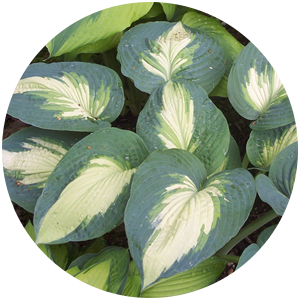
Planting
When choosing a spot to plant ‘Hudson Bay’ hosta, consider that it prefers to grow in morning sun or dappled shade throughout the day. Afternoon sun can be too strong and burn the foliage, especially in warm climates. It will also grow in full shade, meaning less than four hours of direct sun per day.
The first place you might consider planting your new hosta is under a tree. If the tree is deeply rooted, like an oak or hickory, there will be plenty of room for the hosta’s roots to grow. But maples, birches and spruce trees have broad, shallow root systems that could outcompete the hosta for root space and make it grow much slower. Consider root competition when finding the right spot.
‘Hudson Bay’ hosta grows best in humus-rich soil that stays moist and well-drained, but it will also grow reasonably well in sandy and clay soils. If you plan to grow it in a container for the first few years of its life, use a good quality potting soil with a bit of slow release plant food mixed in to help it get off to a strong start.
This hardy perennial isn’t too fussy about when you plant it. Cooler spring and fall weather is ideal, but if summer is your only option, just be sure to plant it in the shade and keep the soil moist through the warmest months while its roots get established.
When planting, dig the hole about twice as wide but just as deep as the container it is growing in. If your soil is light in color–indicating it doesn’t contain much organic matter–add several handfuls of humus, compost or aged manure when you backfill the hole. That will provide extra nutrients and water-holding capacity to the soil.
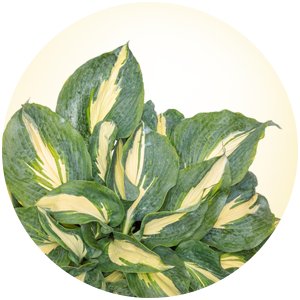
Maintenance
Hostas require very little maintenance during the growing season. They need little more than some shade, good soil and moisture to flourish all on their own.
Watch for rabbits in spring–this is their favorite time of year to munch on hostas. Just as their pointed tips emerge from the soil, a hungry bunny may come along and nip them off. It won’t hurt the hosta but once its leaves unfurl, you’ll see the bunny’s teeth marks. Avoid this by applying animal repellent on your hostas in early spring just as they start to come up.
If deer are an issue in your garden, consider growing more deer resistant plants or plan to protect your hostas with animal repellent or fencing. Taller, thinner leaved cultivars are more prone to damage simply because they are easier for the deer to eat.
During wet weather, slug populations can multiply quickly. If you start seeing holes in your hosta leaves, it’s a sure sign that they have moved in. Here is an article to help you “slug it out” with these pesky creatures.
Hostas should be cut back in fall once their foliage has gone to sleep for the season. Remove the spent foliage from the garden bed and dispose of it to help avoid future slug damage around the plants.
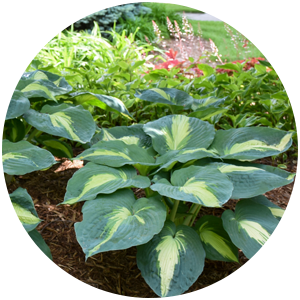
Companion plants
Plants that thrive in the shade provide a scintillating surprise for visitors to your garden. When looking for companions, choose those that prefer similar cultural conditions including partial to full shade and rich, moist soil. Your local garden center likely has a separate section for shade perennials where you’ll find all sorts of companions for this striking variegated hosta.
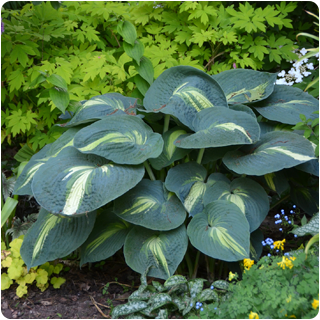
Shadowland® ‘Hudson Bay’ Hosta
You could plant shorter hostas like ‘Wheee!’ nearby to emphasize the large scale of ‘Hudson Bay’. You might also try skirting Dolce® ‘Apple Twist’ coral bells around its perimeter for a bright punch of color. Perennials with silvery foliage like ‘Crested Surf’ Japanese painted ferns, ‘Spot On’ lungwort and heartleaf brunnera complement the cool blue tones in the hosta’s foliage. ‘Gold Heart’ old-fashioned bleeding heart provides a punch of yellow behind ‘Hudson Bay’ in this part shade landscape.
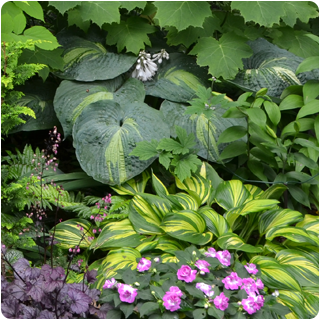
‘Hudson Bay’ Hosta with companion plants
Since this is a taller hosta that tops out around two feet tall, it works well as a backdrop for shorter perennials and flowers. Here, ‘Rainbow’s End’ hosta, Rockapulco® Wisteria double impatiens and Dolce® ‘Wildberry’ coral bells fill the middle and edge of this full shade bed. Since much of the interest in this pairing relies on pretty foliage and the impatiens bloom continuously, this grouping looks fantastic all season with very little maintenance required.
top 3 reasons to
grow ‘Hudson Bay’ Hosta
PLANT IT AND WATCH IT SHINE
This amazing hosta will be one of the prettiest, most low maintenance plants in your garden for decades.
IT THRIVES IN THE SHADIEST GARDENS
While many showy perennials need full sun to grow well, ‘Hudson Bay’ will happily grace your shade garden with its artistically variegated foliage.
IT’S SUPER COLD HARDY
Hardy down to -40®F, you will never have to worry about it returning reliably after winter.
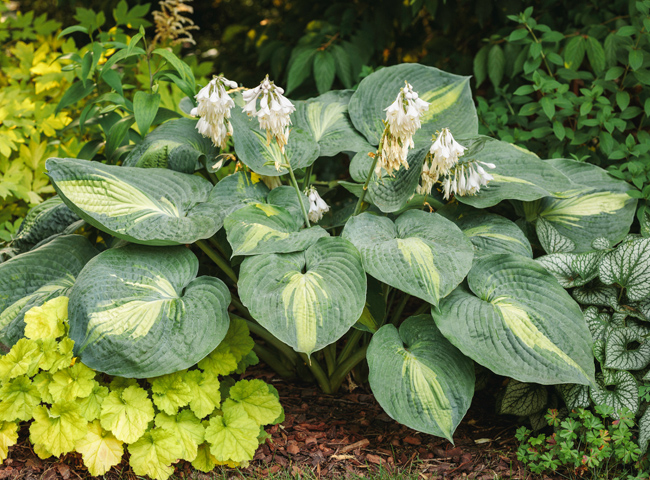
Shadowland® ‘Hudson Bay’ Hosta USPP 23,598, Can 4,947
